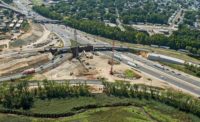New York
City Permits for Residential Units Climb 71%
There's been a resurgence in the New York City housing market as the number of building permits for residential units rose 71% last year to 18,095, according to a recent New York Building Congress analysis of U.S. Census data.
However, the number of permits remains far below the 33,911 units reached at the 2008 peak, the report says. For the first time since 2008, the number of Dept. of Buildings-authorized housing units has grown in each of the city's five boroughs, with Brooklyn leading the pack at 6,140 units, up 83% from the prior year, and Manhattan following with 4,956 units, up 99%. In Manhattan, the rise was largely driven by the start of the 1,168-unit Atelier II building on 42nd St. (see Top Starts story, p. 15).
Queens posted the largest percentage gain with 3,161 units, a rise of 107%. The jump was driven by the start of two affordable housing towers at Hunters Point South in Long Island City that include a total of 941 units, the Building Congress says.
Last year, the number of residential permits issued in Staten Island grew 78% to 1,200, but they rose only marginally in the Bronx, to 2,638 from 2,552.
Tristate
Hospitals Call For Team Flexibility
The ongoing shift to bring health care services to the masses wherever they live has helped to ignite demand for new construction of ambulatory care centers nationwide, said speakers at one of two health care building conferences held last month in Manhattan. The need for hospitals to be made more resilient to major weather events, such as Superstorm Sandy, was the theme of one of the meetings.
"The future is in ambulatory care," Gary Acord, executive director of planning, design and construction at Memorial Sloan Kettering Cancer Center, told attendees at the Future of Health-Care Construction conference, sponsored by ENR New York. "We don't predict a lot of growth in inpatient facilities" or in pure research sites, he added.
As sector demand continues to shift toward these smaller, off-site facilities, institutions expect greater flexibility from their project teams in terms of schedules, costs and whatever unforeseen events may arise, speakers said. These institutions also expect to be given a full picture of costs before the work starts.
"Tell us the bad news at the beginning.… Don't tell us at the end that we need new risers or whatever to support the design," said Marsha Powell, engineering services director at the NYC Health and Hospitals Corp. "Our mandate from our board now is to know what projects cost."
At the After Sandy: Recovery and Resiliency at NYC's Hospitals conference, panelists involved with four waterfront hospitals that were devastated by the October 2012 storm said that, while some progress has been made since then, more work is required. After Sandy's waters surged through these facilities, forcing evacuations and multiweek shutdowns, the hospitals are rebuilding to higher standards—and higher floors—and taking into account other severe weather events.
"We've had tornados, earthquakes and two hurricanes. It always feels like something new," said Daniel Zarrilli, resiliency director in the New York City mayor's office."So, we have to make sure to not always focus on what's happened last but take an all-hazards approach."
While the city has been criticized for moving slowly after the storm, it pledged $20 billion last year to enact 257 initiatives, including safeguarding infrastructure. Most of that total has now been funded, he said.


Post a comment to this article
Report Abusive Comment